SOMME - FRENCH Sector - Dompierre - Becquincourt - Fay - Soyécourt
duda-wsm • 28 March 2019
Year of visit: 2007
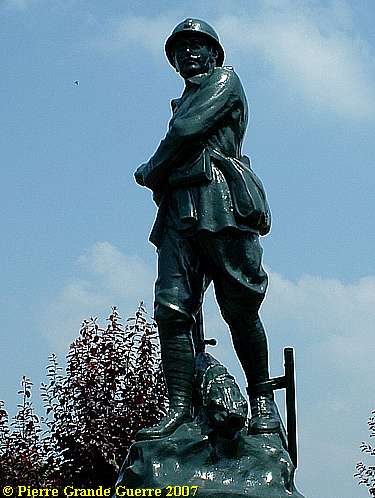
South of the Somme: a visit to the former German lines near
Dompierre - Becquincourt, the lost village of Fay,
and the German Soyécourt Trenches.
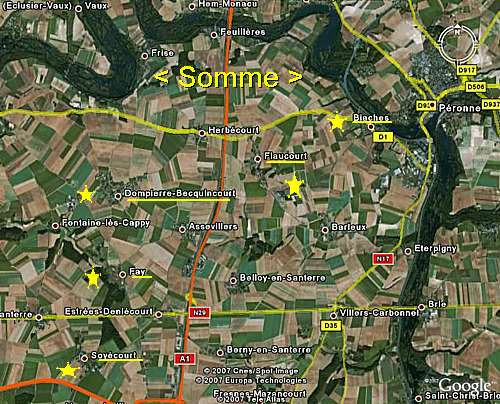
The villages of Dompierre and Fay were partly or totally destroyed. These villages were a part of the 1st German Lines of 1 July 1916. The French Jump Off Lines were west, or north-west of these villages.
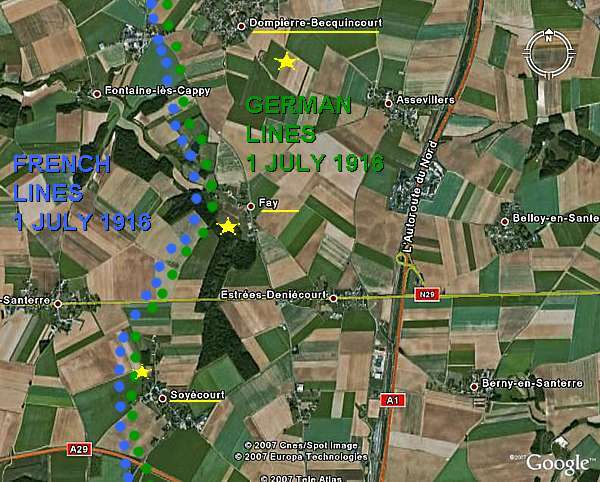
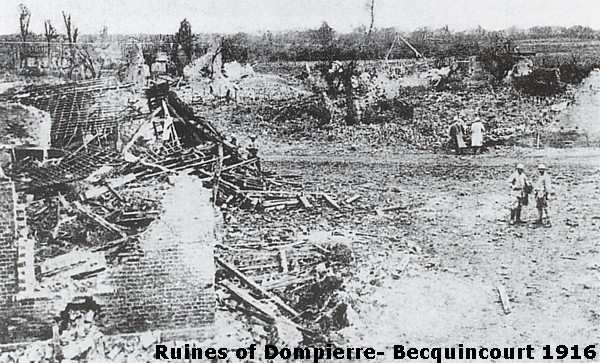
General Fayolle's VIth Army, with a division of the 35th Army Corps and the 1st Colonial Corps as auxiliaries, captured the villages of Dompierre and Fay on the first day of the Battle of the Somme.
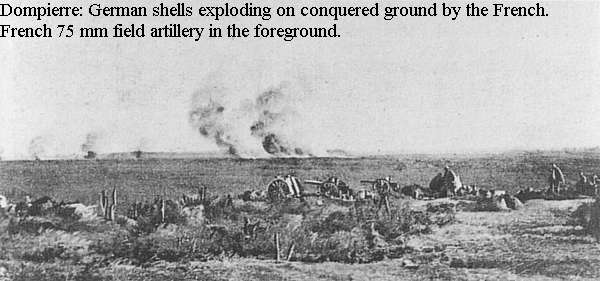

We start at the monument, a "Poilu" statue, on the edge of Dompierre village.
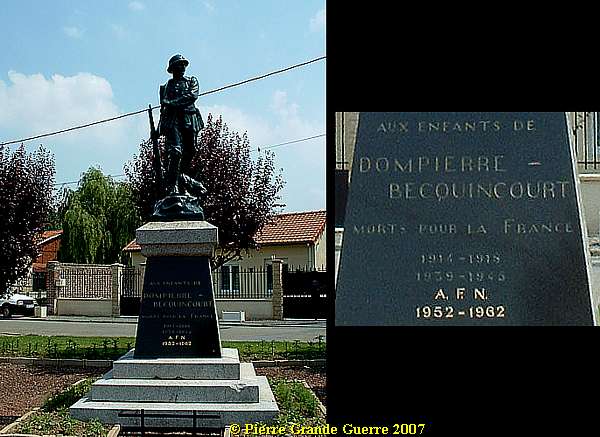
Just outside the village, along the D71 southward, lies the French Military Cemetery.
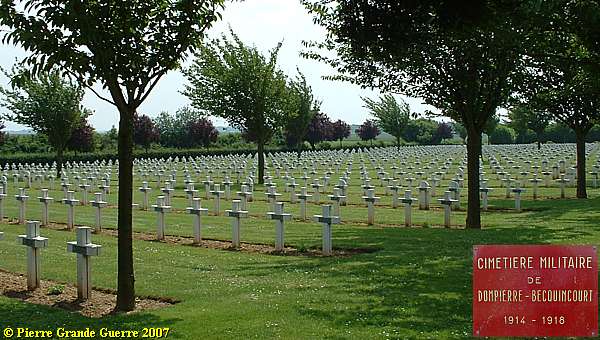
The cemetery contains 7,032 graves of soldiers, killed during all the Somme battles of 1914-1918.
1,671 Soldiers rest in 4 mass graves.
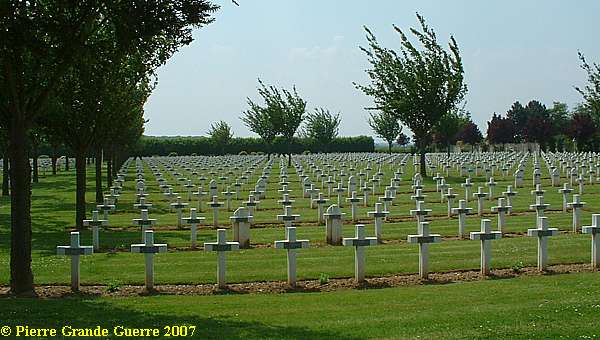
We continue to the destroyed village of Fay.
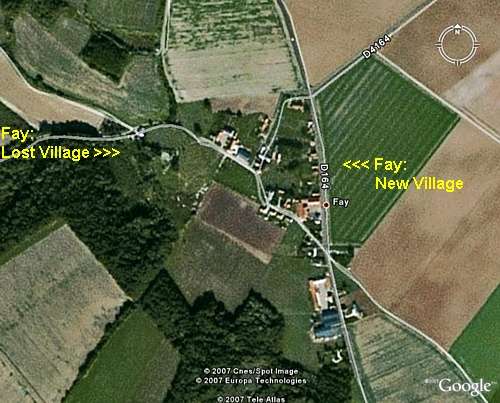
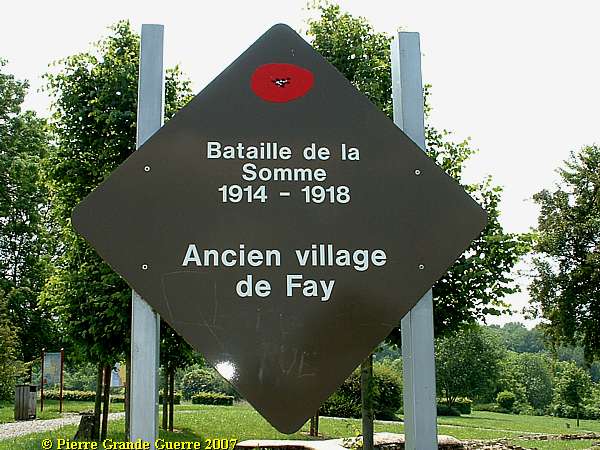
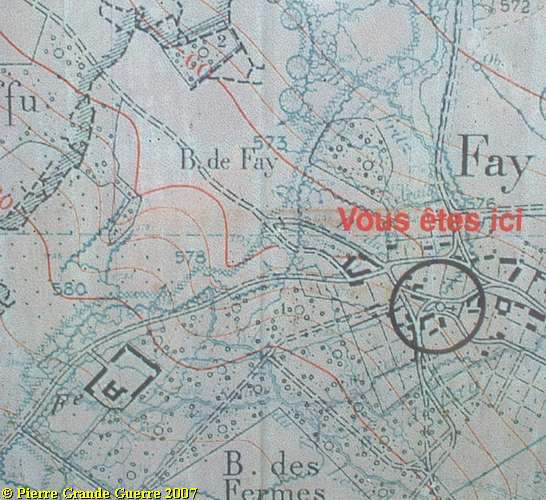
The Germans occupied Fay quite early in the war, in September 1914. The Germans had dug in the ruines of the village,
and used its ruines for fortifications and machine gun posts.
The village of Fay was already completely destroyed before the Battle of the Somme.
After the war, in the 1920's, the inhabitants of Fay raised a new village some 200 meters eastward.
"You are here", tells this trench map copy on the spot, marking the German lines; saw tooth lines for trenches, xxx-s for barbed wire obstacles.
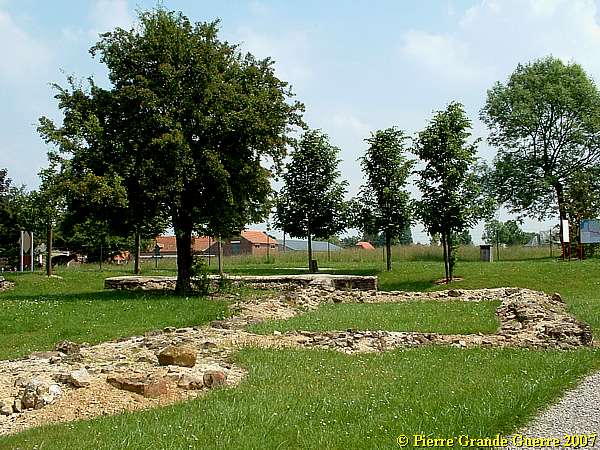
Nowadays you can only detect the ruines of the foundations of the lost village, like the apsis of the former village church.
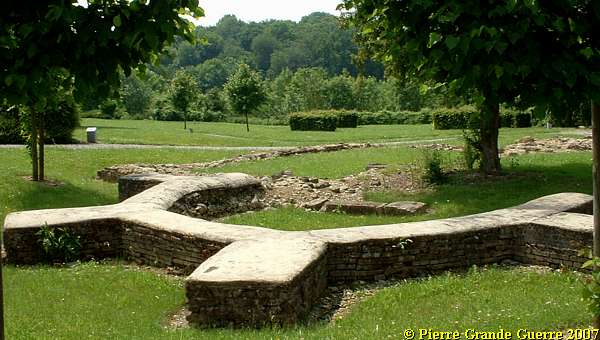
This used to be the portal to the church. We look "through" the church into the direction of the apsis.

These foundations mark the house and shop of the local bakery.
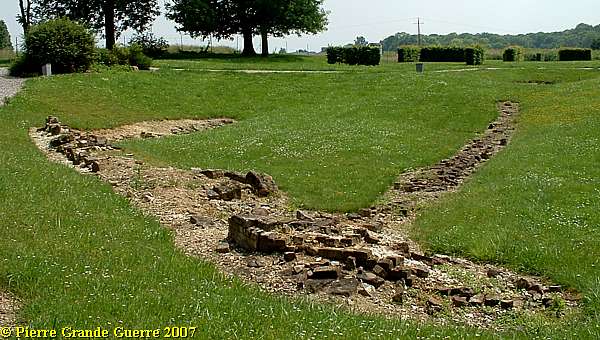
We went on southward, to the German Trenches of Soyécourt . North, just outside the village of Soyécourt,
is the copse of Bois de Wallieux.
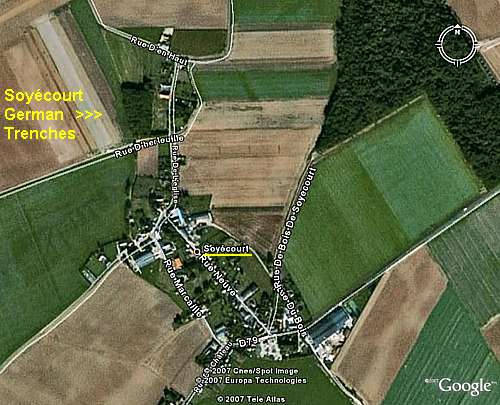
Under the trees traces of shell holes and traces of trenches of the
German
1st lines
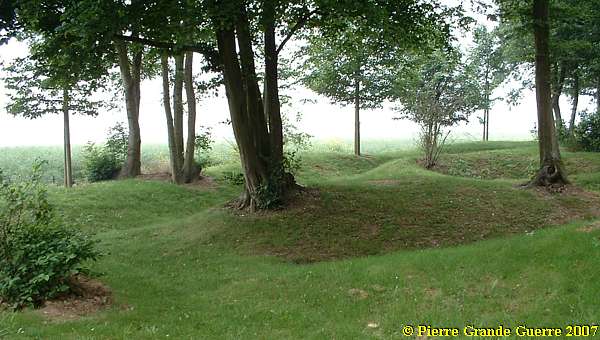
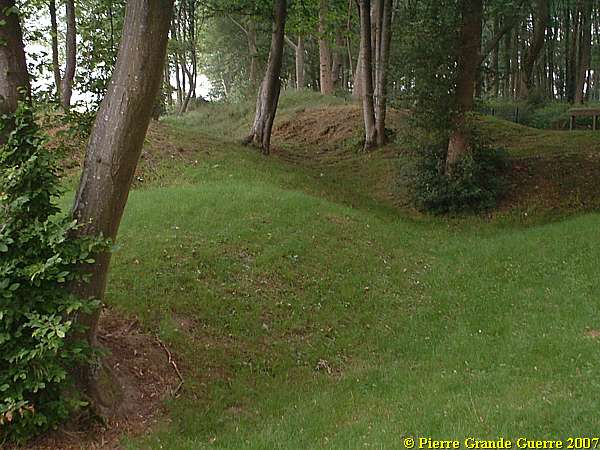
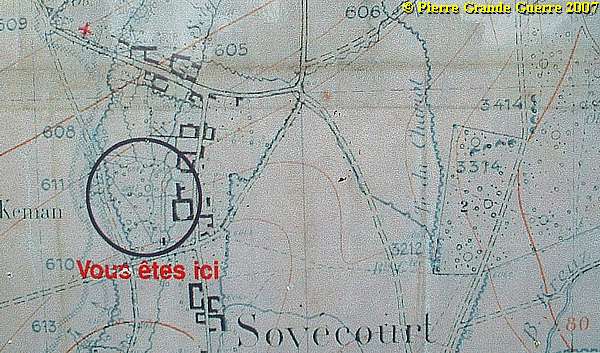
The
French Xth Army, under command of General Micheler, captured these
German trenches,
at great pains on 20 July 1916.
On some spots in the copse you will find signs with period photographs of French troops,
occupying these trenches from 20 July 1916 until January 1917,
when this sector was taken over by the British 48th Division. These images present you an impression of the French occupation of these trenches.
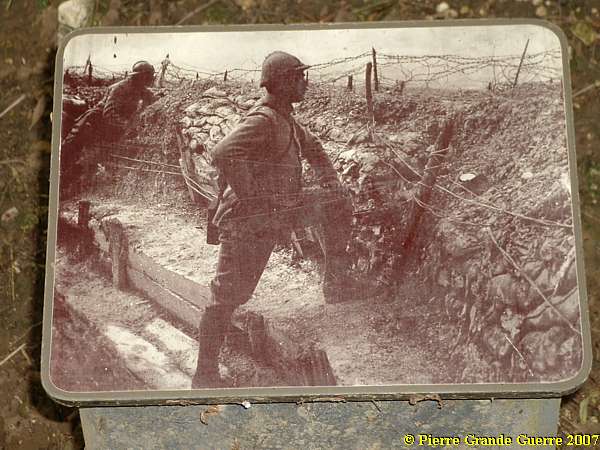

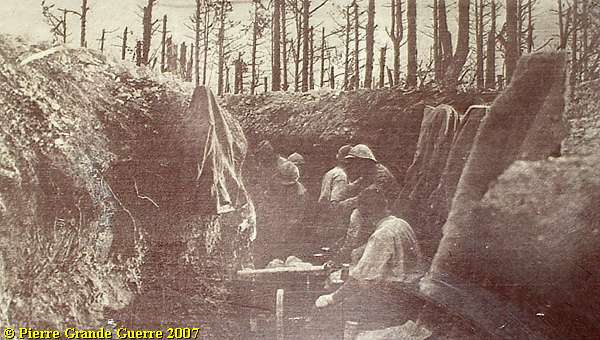
The "Conseil Géneral de Somme / Historial" has chosen for a natural way of preserving these trenches.
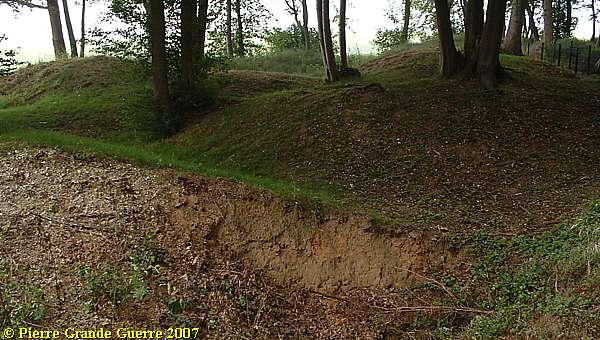
A filled in entrance to a German dug-out.
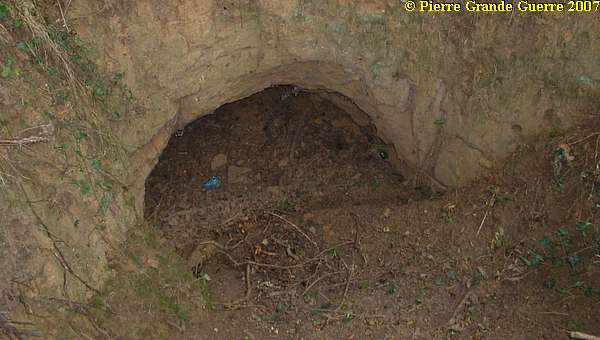
View south-eastward over the trenches.
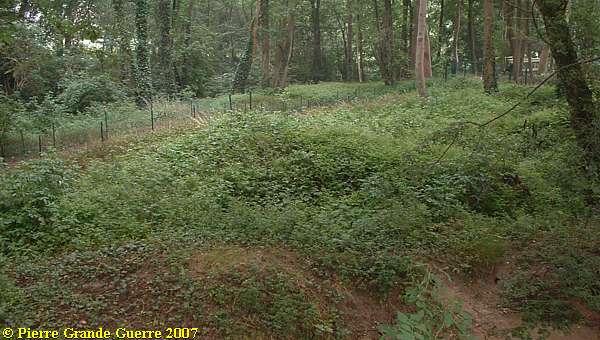
An ventilation shaft of a dug-out.
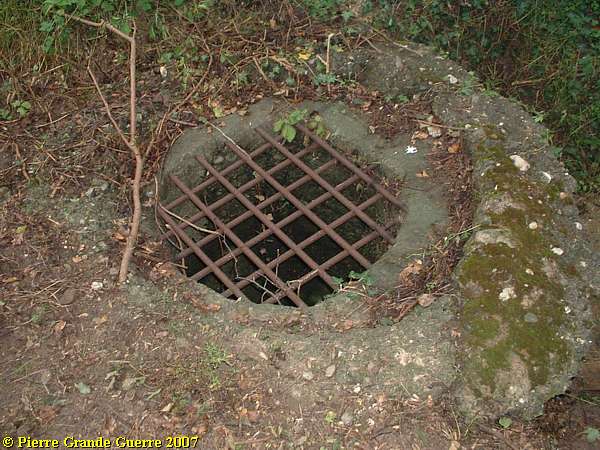
View from south to east. Notice the large shell hole.
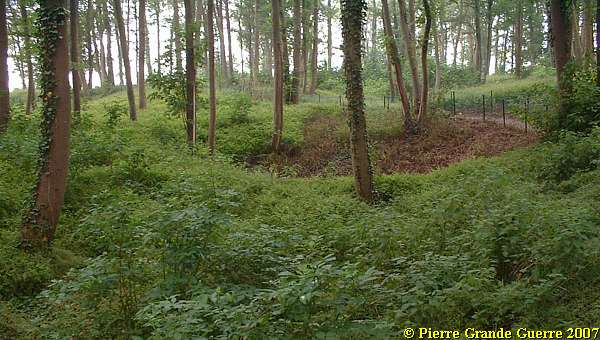
With a last view over the Soyécourt trenches we continue following the traces ...
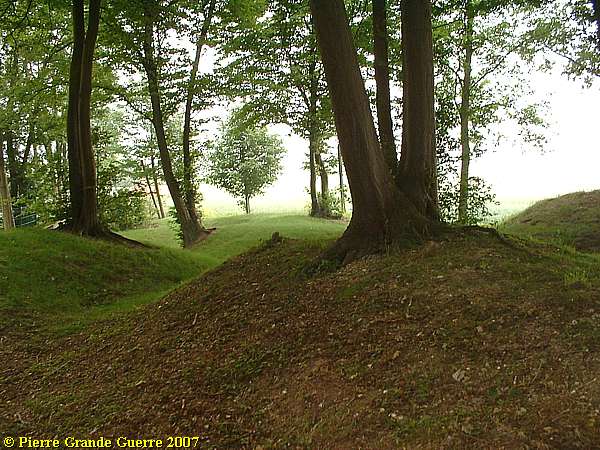
...of the 1st Colonial Corps of the VIth Army into the direction of the breach in the German lines at the Plateau de Flaucourt.
Continue
to the next chapter: " Flaucourt -
Biaches
".

Inleiding: Franz Von Papen & Werner Horn; schaker en pion Onlangs stuitte ik in een oud boek (1) van 1919 op een opmerkelijk verhaal over een Duitse Luitenant, die in begin februari 1915 een half geslaagde bomaanslag pleegt op een spoorbrug over een grensrivier tussen de Verenigde Staten en Canada. Ook al staat de bekentenis van de dader, Werner Horn, deels in het boek te lezen, de naam van zijn opdrachtgever zal Horn blijven verzwijgen. Na wat verder zoeken vond ik ook de naam van Horn’s opdrachtgever, Franz von Papen, een van de aangeklaagden van het latere Neurenberg Proces in 1946. In een Grote Oorlog als de Eerste Wereldoorlog is Horn’s aanslag op de brug uiteraard slechts een bescheiden wapenfeit. Toch vermoed ik dat dit relatief onbekende verhaal, dat de geschiedenis is ingegaan als de “ Vanceboro International Bridge Bombing ”, nog interessante kanten kent. Het is onder andere een spionageverhaal over hoe in een groter plan een sluwe schaker zijn naïeve pion offert. Beknopte situatieschets Canada en de Verenigde Staten in 1915

This trip we start at the Léomont near Vitrimont and we will with some exceptions concentrate on the Battle of Lorraine of August-September 1914 in the area, called, the “Trouée de Charmes”, the Gap of Charmes. After the Léomont battlefield we continue our explorations to Friscati hill and its Nécropole Nationale. Next we pay a visit to the battlefield of la Tombe to go on to the Château de Lunéville. There we cross the Vezouze to move on southward to the Bayon Nécropole Nationale. At Bayon we cross the Moselle to pass Charmes for the panorama over the battlefield from the Haut du Mont. North-west of Charmes we will visit the British Military Cemetery containing 1918 war victims. From Charmes we go northward to the battlefield of the First French Victory of the Great War, the Battle of Rozelieures of 25 August 1914. North of Rozelieures we will visit the village of Gerbéviller. From there we make a jump northward to visit the ruins of Fort de Manonviller to finish with an interesting French Dressing Station bunker, west of Domjevin.

Though we depart from Badonviller in the Northern Vosges , we make a jump northward to the east of Lunéville and Manonviller . We start at Avricourt on the border of Alsace and Lorraine. From the Avricourt Deutscher Soldatenfriedhof we explore the southern Lorraine battlefields ; the mine craters of Leintrey , the Franco- German war cemetery and Côte 303 at Reillon , and some German bunkers near Gondrexon , Montreux , and Parux .

North-east of Nancy, east of Pont-à-Mousson, and south-east of Metz we visit the battlefields of the Battle of Morhange of 14 until 20 August 1914. We follow mainly topographically the route of the French advance eastward over the Franco-German border of 1871-1918. During this visit, we try to focus on the day that the momentum of the battle switched from the French side to the advantage of the Bavarian side: the day of 20 August 1914, when the Bavarians rapidly re-conquered the territory around Morhange , being also the day of the start of their rather successful “Schlacht in Lothringen”. We will visit beautiful landscapes of the "Parc Naturel Régional de Lorraine", memorials, ossuaries, and cemeteries. Sometimes we will divert to other periods of the Great War, honouring Russian and Romanian soldiers, who died in this sector. We start our route at the border village of Manhoué, and via Frémery, Oron, Chicourt, Morhange, Riche, Conthil, Lidrezing, Dieuze, Vergaville, Bidestroff, Cutting, Bisping we will finish in Nomeny and Mailly-sur-Seille, where the Germans halted their advance on 20 August 1914, and where they constructed from 1915 some interesting bunkers.

South of Manhoué we start this trip at Lanfroicourt along the French side of the Franco-German 1871-1918 border, marked by the meandering Seille river. We visit some French bunkers in Lanfroicourt, near Array-et-Han and in Moivrons. From there we go northward to the outskirts of Nomeny and the hamlet of Brionne to visit the ( second ) memorial, commemorating the events in Nomeny of 20 August 1914. We continue westward to finish at the Monument du Grand Couronné at the Côte de Géneviève, a former French artillery base, which offers several panoramic views over the battlefield.

North of Pont-à-Mousson and south of Metz, we explore the relics of German bunkers and fortifications along the Franco-German 1871-1918 border. We start at Bouxières-sous-Froidmont to visit the nearby height of the Froidmont on the front line. This time we will show only a part of the Froidmont, focusing on its military significance. From the Froidmont we continue via Longeville-lès-Cheminot and Sillegny to the “Forêt Domaniale de Sillegny” to explore some artillery ammunition bunkers. Next we continue to Marieulles for its three interesting bunkers and to Vezon for its line of ammunition depot bunkers. From Vezon we continue to the “Deutscher Kriegsgräberstätte Fey – Buch”. From Fey we go eastward, passing 6 bunkers near Coin-lès-Cuvry to finish our trip at the top construction of the “Feste Wagner” or “Fort Verny”, north of Verny.

We concentrate on the German side of the front around "Markirch", Sainte Marie-aux-Mines, the so-called "Leber" front sector . We first pay a visit to the Sainte-Marie-aux-Mines Deutscher Soldatenfriedhof, and next to the southern side of the Col de Ste. Marie for the many interesting bunkers of the German positions at the Bernhardstein, at the north-eastern slopes of the Tête du Violu. On the next photo page about the Haut de Faîte we will continue with a visit to the northern side of the pass and the "Leber" sector.



